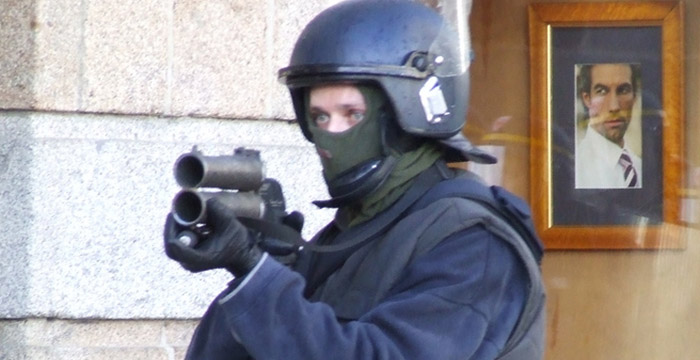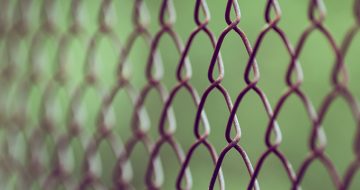As gory reports of injuries increase, French police are increasingly criticised for deploying this controversial weapon

As the gilets jaunes recover from their most recent demonstration, so-named ‘Act 10’, two long months since the crisis first erupted in France, attention is turning to the escalating violence at these events. Social media is flooded with hundreds of videos of burning bins and cars and smashed shop windows. To these images have been added a multitude of accounts of disproportionate violence on the side of the police.
In order to disperse the mass of yellow vests invading the streets of the French capital each Saturday, police officers were originally equipped with tear-gas grenades and, with the help of local firefighters, water cannons. In the last weeks, however, an increasing number of policemen have been spotted using flash-ball guns and LBD 40 weapons. According to French news channel BFMTV, at least 80 demonstrators have now been seriously wounded by these semi-rigid rubber balls.
France is one of the few countries in Europe that uses these types of weapons, seen as alternatives to fire weapons. Originating from France and used there since the 1980s, the non-lethality of their impact is guaranteed by the fact that the flash-ball itself is a rubber bullet and doesn’t have the aim of fatally wounding anyone hit by it.
According to the French law, le code de sécurité intérieure, flash-ball weapons (described as non-lethal 44-mm gauge weapons) and their successor LBD 40 guns, are only to be used in cases of absolute necessity and in a strictly proportionate manner. They should also only be aimed at the individual’s torso and superior limbs. In any event, the head and genitals should at all times be avoided.
In the context of the yellow vest crisis, it appears that these rules are unfortunately not strictly applied. As such, the past demonstrations have seen a multitude of individuals being hit by flash-balls in these prohibited body areas. Amongst the first to be severely injured, 25 year-old Antoine lost the sight of one of his eyes after being struck by one of the notorious rubber bullets, while filming the protests on the street.
Want to write for the Legal Cheek Journal?
Find out moreSince then, more accounts of severe injuries have appeared on social media platforms. The major concern is that the French police officers are not only targeting violent demonstrators but also several French journalists and photographers have been the victims of flash-ball shots. More worryingly, one of the recent flash-ball incidents involved a teenager casually shopping in Strasbourg last Saturday. Fifteen year-old Lilian, who was not a part of the demonstrations and thus was not wearing a yellow vest, was struck in the jaw leading to the perforation of his cheek.
While the use of these weapons is clearly disproportionate, these dramatic incidents are often being justified by the lack of knowledge on the use of flash-ball guns: French author David Dufresne argues that the officers using these weapons during the current demonstrations are generally trained to use lethal weapons and have no experience in the maintenance of public order.
It is also the case that since the Paris attacks in 2015, the French police force has been constantly over-worked and at this point are certainly begging for a moment of calm in the country. Whether these facts justify their violent backlash against the demonstrators is another question.
These growing concerns have now made their way to the European Court of Human Rights (ECHR). In December 2018, the court received an application concerning the provisional ban of flash-ball guns in France after high-school students were hit by the rubber bullets. The application was based on Rule 39 of the Rules of the Court, which deals with the indication of interim measures in the event where there is “an imminent risk of irreparable harm”. The application was however rejected by the court, which argued that it only allows requests for interim measures on an exceptional basis where, “in the absence of such measures, applicants would be exposed to real risk of irreparable damage”.
It is not the first time that the French courts have had to deal with the matter. In 2016, the correctional court of Bobigny heard the testimonies of an individual who had lost the sight of one of his eyes after being hit, finding a policeman guilty and issuing a three-year prison sentence.
Despite the rejection of the application at the ECHR, it is certain that a number of other applications will emerge in the upcoming weeks. The pressure is on: in the first weeks of January, politician Jacques Toubon publicly discussed the necessity to ban flash-ball guns due to the dangers involved and the lack of knowledge regarding its command. Just this week, UK media reported that the French police watchdog had opened 101 investigations involving flash-ball injuries, and lawyers have written to the French interior ministry requesting a ban.
Yellow vest supporters (and bystanders and the media) are more than ever hoping for the implementation of measures to limit the use of this, though not lethal, very controversial weapon.
Chloe Batchelor is completing a bachelors in international and European law at The Hague University, Netherlands.



Please bear in mind that the authors of many Legal Cheek Journal pieces are at the beginning of their career. We'd be grateful if you could keep your comments constructive.